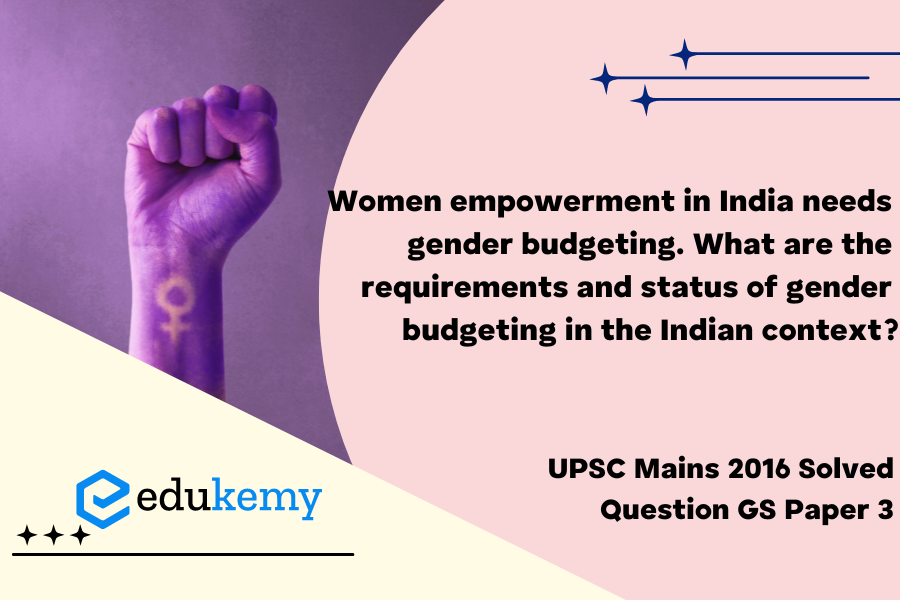Women empowerment in India is a critical societal imperative, and an essential tool for achieving this goal is gender budgeting. Gender budgeting involves the integration of a gender perspective into the budgetary process to address the specific needs and challenges faced by women. In the Indian context, the requirements for effective gender budgeting include a comprehensive understanding of the diverse needs of women across different regions and socioeconomic backgrounds. Adequate funding must be allocated to programs and policies that promote women’s empowerment, education, healthcare, and economic opportunities. Currently, the status of gender budgeting in India reflects progress, but challenges persist. While there has been an acknowledgment of the importance of gender-responsive budgeting, implementation gaps, lack of disaggregated data, and limited awareness hinder its effectiveness. To truly foster women’s empowerment, it is imperative to enhance the commitment towards gender budgeting, ensuring a targeted and inclusive approach that uplifts women across the spectrum of Indian society.
Tag: Government budgeting.
Contents
Decoding the Question:
- In the Intro, try to Start your answer with defining Gender Budgeting or Women empowerment.
- In the Body, Explain the requirements and status of gender budgeting.
- Try to conclude the answer as per the context.
Answer:
Gender Budgeting is a powerful tool for achieving gender mainstreaming so as to ensure that benefits of development reach women as much as men.The rationale for gender budgeting arises from recognition of the fact that national budgets impact men and women differently through the pattern of resource allocation. Women constitute 48% of India’s population, but they lag behind men on many social indicators like health, education, economic opportunities, etc. Hence, they warrant special attention due to their vulnerability and lack of access to resources. The way Government budgets allocate resources, has the potential to transform these gender inequalities. In view of this, Gender Budgeting, as a tool for achieving gender mainstreaming, has been propagated.
Current status of gender budgeting in India:
- The Gender Budget Statement was first introduced in Budget 2005-06. Various ministries and departments provide information to the finance ministry based on which Gender Budget Statement is prepared.
- This helps to monitor expenditure and public service delivery from a gender perspective, as a means of mainstreaming women’s concerns in all activities and improving their access to public resources.
- Also it was instructed to all the ministries and departments, to open Gender Budgeting Cell (GBC).
- Ministry and Government Departments have been instructed to open Gender Budgeting Cells (GBC). Presently, 57 Ministries and Departments have established GBC.

- Only one-third of all the demands for grant presented to the Union government are reported in the gender budgeting statement.
- Of the total budgetary allocation of the Ministry of Women and Child Development, only 15% of the amount is actually spent on Women and Women related schemes.
Requirements of Gender budgeting for women empowerment in India:
- There are certain women issues which can be attended to on priority through gender budgeting. For example, women security, specific budgetary allocation has been done under Nirbhaya fund.
- Gender budgeting aims at making society more gender equal by allocating resources to programmes and schemes that will reduce and eliminate prejudice existing against a particular gender.
- With literacy rate just about 65%, and making up 48% of India’s population, women lag behind in equitable participation in the economy (Labour force participation is just 33%). Financial allocation through gender budgeting serves as a potent tool to ensure the economic empowerment of women (e.g. differential rates for men and women in property tax rates etc.).
- Gender budgeting helps in the assessment of the extent to which the sector’s policy addresses the gender issues and gaps. This keeps women’s empowerment a priority agenda of the government.
However not all is negative about Gender budgeting in India, certain new trends are encouraging. A positive trend over the past couple of years has been the pre-budget consultations organized by the Ministry of Finance, aimed at ensuring that the voices of women are also heard in the budget-making process. The Finance Minister has proposed to increase the gender budget allocation to Rs 131,700 crore for 2019-20 from Rs 121,961 crore a year ago.
In case you still have your doubts, contact us on 9811333901.
For UPSC Prelims Resources, Click here
For Daily Updates and Study Material:
Join our Telegram Channel – Edukemy for IAS
- 1. Learn through Videos – here
- 2. Be Exam Ready by Practicing Daily MCQs – here
- 3. Daily Newsletter – Get all your Current Affairs Covered – here
- 4. Mains Answer Writing Practice – here


